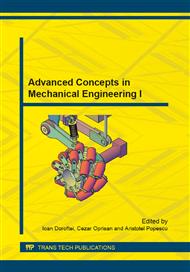[1]
S. Portnoy, et. all., Surgical and Morphological Factors that Affect Internal Mechanical Loads in Soft Tissues of the Transtibial Residuum, Annals of Biomedical Engineering. 37(12) (2009) 2583–2605.
DOI: 10.1007/s10439-009-9801-3
Google Scholar
[2]
J Z. Shuxian, Z. Wanhua, L. Bingheng, 3D reconstruction of the structure of a residual limb for customizing the design of a prosthetic socket, Medical Engineering & Physics. 27 (2005) 67–74.
DOI: 10.1016/j.medengphy.2004.08.015
Google Scholar
[3]
S.G. Zachariah, J.E. Sanders, Finite element estimates of interface stress in the trans-tibial prosthesis using gap elements are different from those using automated contact, Journal of Biomechanics. 33 (2000), pp.895-899.
DOI: 10.1016/s0021-9290(00)00022-1
Google Scholar
[4]
W.C.C. Lee, M. Zhang, X. Jia, J.T.M. Cheung, Finite element modeling of the contact interface between trans-tibial residual limb and prosthetic socket, Medical Engineering & Physics. 26 (2004) 655–662.
DOI: 10.1016/j.medengphy.2004.04.010
Google Scholar
[5]
W.C.C. Lee, M. Zhang, Using computational simulation to aid in the prediction of socket fit: A preliminary study, Medical Engineering & Physics. 29 (2007) 923–929.
DOI: 10.1016/j.medengphy.2006.09.008
Google Scholar
[6]
Giorgio Colombo, Stefano Filippi, Caterina Rizzi, Federico Rotini, A new design paradigm for the development of custom-fit soft sockets for lower limb prostheses, Computers in Industry 61 (2010) 513–523.
DOI: 10.1016/j.compind.2010.03.008
Google Scholar
[7]
D. Lacroix, J.F.R. Patino, Finite Element Analysis of Donning Procedure of a Prosthetic Transfemoral Socket, Annals of Biomedical Engineering. 39(12) (2011) 2972–2983.
DOI: 10.1007/s10439-011-0389-z
Google Scholar
[8]
A. Sadeeq Ali, et. all, Clinical investigation of the interface pressure in the trans-tibial socket with Dermo and Seal-In X5 liner during walking and their effect on patient satisfaction, Clinical Biomechanics. 27 (2012) 943–948.
DOI: 10.1016/j.clinbiomech.2012.06.004
Google Scholar
[9]
S. Portnoy, at. all., Internal mechanical conditions in the soft tissues of a residual limb of a trans-tibial amputee, Journal of Biomechanics. 41 (2008) 1897–(1909).
DOI: 10.1016/j.jbiomech.2008.03.035
Google Scholar
[10]
W. Li, M. Kong, X.D. Liu, Z.R. Zhou, Tribological behavior of scar skin and prosthetic skin in vivo, Tribology International. 41 (2008) 640–647.
DOI: 10.1016/j.triboint.2007.11.009
Google Scholar
[11]
W. Li, X.D. Liu, Z.B. Cai, J. Zheng, Z.R. Zhou, Effect of prosthetic socks on the frictional properties of residual limb skin, Wear. 271 (2011) 2804– 2811.
DOI: 10.1016/j.wear.2011.05.032
Google Scholar
[12]
S. Derler, L. -C. Gerhardt, Tribology of Skin: Review and Analysis of Experimental Results for the Friction Coefficient of Human Skin, Tribol Lett. 45 (2012) 1–27.
DOI: 10.1007/s11249-011-9854-y
Google Scholar
[13]
M. Zhang, A.F.T. Mak, A Finite Element Analysis of the Load Transfer Between an Above-Knee Residual Limb and Its Prosthetic Socket-Roles of Interface Friction and Distal-End Boundary Conditions, IEEE Transactions on Rehabilitation Engineering. 4(4) (1996).
DOI: 10.1109/86.547935
Google Scholar
[14]
M. Barbara Silver-Thorn, Parametric analysis using the finite element method to investigate prosthetic interface stresses for persons with trans-tibial amputation, Journal of Rehabilitation Research and Development. 33(3) (1996) 227-238.
Google Scholar
[15]
M. Tanaka, Y. Akazawa, A. Nakagawa, I. Kitayama, Identification of pressure distribution at socket interface of above-knee prosthesis , Transactions on Biomedicine and Health. 2 (1995).
DOI: 10.1016/s0965-9978(96)00048-8
Google Scholar


